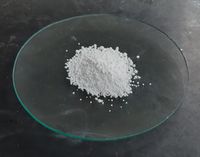Potassium carbonate
 Prilled potassium carbonate
| |
| Names | |
|---|---|
| IUPAC name
Potassium carbonate
| |
| Other names
Carbonate of potash
Dipotassium carbonate Pearl ash Potash Salt of tartar Salt of wormwood Sub-carbonate of potash | |
| Properties | |
| K2CO3 | |
| Molar mass | 138.205 g/mol |
| Appearance | White hygroscopic solid |
| Odor | Odorless |
| Density | 2.43 g/cm3 |
| Melting point | 891 °C (1,636 °F; 1,164 K) |
| Boiling point | Decomposes |
| 105.5 g/100 ml (0 °C) 108 g/100 ml (10 °C) 112 g/100 ml (20 °C) 114 g/100 ml (30 °C) 156 g/100 ml (100 °C) | |
| Solubility | Reacts with acids Insoluble in acetone, ethanol, hydrocarbons |
| Solubility in methanol | 3.11 g/100 ml (25 °C) |
| Vapor pressure | ~0 mmHg |
| Hazards | |
| Safety data sheet | Sigma-Aldrich |
| Flash point | Non-flammable |
| Lethal dose or concentration (LD, LC): | |
| LD50 (Median dose)
|
1,870 mg/kg (rat, oral) |
| Related compounds | |
| Related compounds
|
Lithium carbonate Sodium carbonate Rubidium carbonate Caesium carbonate Potassium bicarbonate |
| Except where otherwise noted, data are given for materials in their standard state (at 25 °C [77 °F], 100 kPa). | |
| Infobox references | |
Potassium carbonate, sometimes referred to in historical literature as potash, is an inorganic compound with chemical formula K2CO3. It is a basic and somewhat hygroscopic crystalline solid, readily forming a solution that feels slippery to the touch.
Contents
Properties
Chemical
Potassium carbonate reacts with acids to release carbon dioxide.
- K2CO3 + HCl → KCl + H2O + CO2
Physical
Potassium carbonate is a white deliquescent solid. It is soluble in water, but not ethanol. K2CO3 decomposes at 891°C.
Availability
Potassium carbonate can be purchased online cheaply.
Preparation
Historically, potassium carbonate was obtained through the leaching of wood ash, producing a yellowish powder referred to as lye, which consisted of varying portions of potassium and sodium carbonates and a variety of other impurities. This mixture, while unsuitable for analytical chemistry, can still find some applications today, such as in food preparation (such as in traditional Japanese ramen) and soap-making. Sodium carbonate can be removed, however, by concentrating a solution of the wood lye and cooling it to near freezing. Sodium carbonate is much less soluble than potassium carbonate, and will easily crystallize out. Some of the other impurities precipitate from the evaporating solution even earlier, as brown goop that can be filtered out.
The ash of banana peels are a good source of potassium carbonate, and it's relative easy to obtain a relative pure compound, though you will need a very large amount of banana peels, as a significant percentage of their mass is water.[1][2]
A more modern method of preparing potassium carbonate, but still a crude one, is by burning a mixture of finely ground potassium nitrate and carbon (or potassium nitrate and sugar), usually in the form of coke or charcoal. To ensure that all potassium nitrate reacts, an excess of carbon should be used, and the two reactants mixed very well. This reaction produces large, bright magenta or fuchsia flames and thick white smoke, and should only be performed outside. The end product of this reaction can be leached with water, crystallized by evaporation or boiling, and washed in hot acetone. Care must be taken when working with the reaction product as it may contain potassium cyanide.
Projects
Potassium carbonate is useful for the production of potassium salts in the lab, and can serve as a substitute for potassium hydroxide for many applications. One unique application for potassium carbonate is the salting-out of ethanol or methanol. When added in the correct proportion to a solution of ethanol and water and dissolved, potassium carbonate causes the solution to separate into two phases, one of which is nearly pure ethanol. This principle may also be useful in distillations to break the naturally occurring azeotrope of ethanol and water.
Handling
Safety
Potassium carbonate has low toxicity, and may be used as antacid. However, being hygroscopic, it may cause skin irritation.
Storage
Potassium carbonate should be stored in closed bottles, in a dry place.
Disposal
As it is non-toxic, it can be safely diluted and dumped in the ground, as potassium fertilizer for plants.